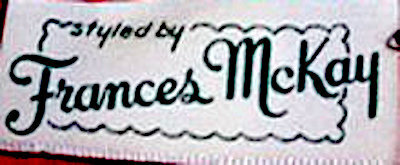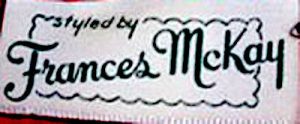Rice-Stix may sound like a breakfast cereal, but it is the name of the St. Louis manufacturer of textile goods that produced and sold the Frances McKay line of “Misses’ and Ladies’ Frocks.”
Henry Rice, William Stix, and Benjamin Eiseman started the Rice-Stix Dry Goods business in Tennessee in 1861. Because of concerns about epidemics of yellow fever, in 1879 they moved the business to St. Louis, where they prospered and grew.
The Bavaria-born Rice and Stix families were soon prominent in Jewish community activities and much respected for their philanthropy and those celebrated activities, such as sponsoring German Jews, to rescue them from the Nazi Holocaust. Among those grateful refugees is the family of a man who became a Nobel Laureate in physics.
The number of Rice-Stix brands expanded considerably and, according to their trademark application, the Frances McKay line was introduced in the late 1930s. The name Frances McKay was described as “fanciful” and the product was described as misses’ and ladies’ frocks. The company claimed use of the Frances McKay name since Sept. 1, 1939, although a 1937 ad was found for “Durian Crepes” dresses styled by Frances McKay.
In the 1950s Rice-Stix allegedly became the largest apparel manufacturer in the country. Ads for their apparel included the following items and comments: robes, junior dresses, house dresses, misses and half-size dresses, jumper dresses, culottes, gingham every-day dresses; apparel made of cotton, spun rayon, Galey & Lord gingham fabrics, rayon challis, rayon flannel, linen-like rayon, rayon crepe; and “lovely enough to receive unexpected guests,” “practical enough for simple daily tasks,” “sanforized and washable,” “crease-resistant linen-like rayon for longer wear,” dresses to “wear everywhere,” “versatile,” “colorfast,” “generous hems,” “cool, crisp, and washable,” and “simple designs.”
The success of Stix-Rice, Inc. apparently caught the interest of other manufacturers and in 1954 apparel manufacturer Reliance Manufacturing Company announced it controlled “more than the majority of all outstanding voting stock of Rice-Stix, Inc.” In 1955 textile manufacturer Safie Bros. Co. acquired controlling interest in Reliance Manufacturing Company, which ended a long struggle between the two New York firms for control of Rice-Stix, Inc. The last ad found for Frances McKay clothing was dated 1959.
Written by LKRanieri

